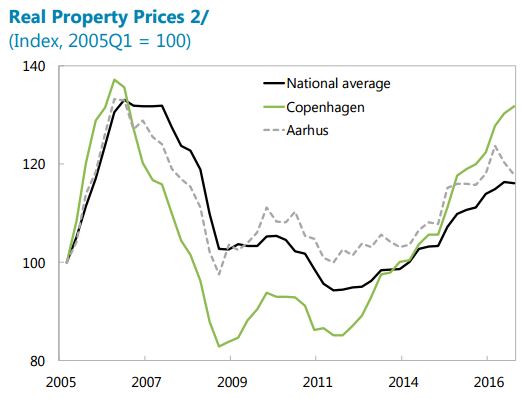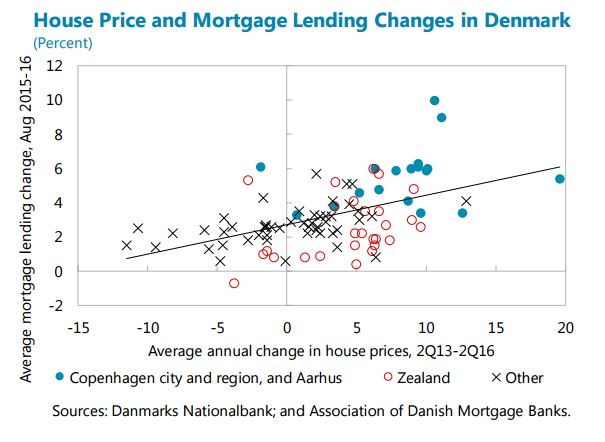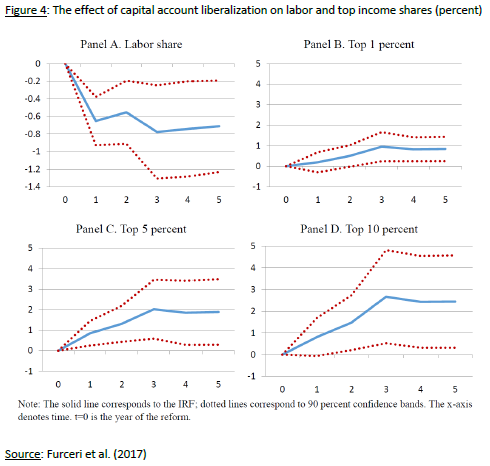Wednesday, June 21, 2017
Denmark’s Housing Market
“House prices continue to rise, particularly in regions with strong new credit creation (…) While a shock to the housing market would probably not pose an acute threat to the banking system, macroeconomic risks are substantial (…) The authorities are considering additional macroprudential measures to curb risks (…) A recently agreed reform of property taxation is a step forward (…) [IMF] Staff advocated pushing ahead with macroprudential and other policies to safeguard macrofinancial stability. Recommended measures span several policy areas. (…) Staff reiterated its call for putting in place a DTI limit and welcomed the SRC’s proposal (…) The broad housing recovery and current low interest rates provide a conducive environment for reducing the tax deductibility of mortgage interest expenses and for further lowering, beyond what is currently planned, the value of the deduction for interest payments (…) Addressing longstanding housing supply constraints, such as strict zoning regulations, procedures for land development, and rental market regulations, can also help ease housing price pressures by improving the responsiveness of supply to housing demand (…) The authorities agreed that house price increases in certain areas called for vigilance”, according to the IMF’s latest report on Denmark.
“House prices continue to rise, particularly in regions with strong new credit creation (…) While a shock to the housing market would probably not pose an acute threat to the banking system, macroeconomic risks are substantial (…) The authorities are considering additional macroprudential measures to curb risks (…) A recently agreed reform of property taxation is a step forward (…) [IMF] Staff advocated pushing ahead with macroprudential and other policies to safeguard macrofinancial stability. Recommended measures span several policy areas.
Posted by at 2:26 PM
Labels: Global Housing Watch
Thursday, June 15, 2017
Rodrik on Financial Globalization and Inequality
Dani Rodrik writes:
“Financial globalization appears to have produced adverse distributional impacts within countries as well, in part through its effect on incidence and severity of financial crises. In a remarkable series of papers, researchers at the IMF have documented these negative inequality impacts (Jaumotte et al. 2013; Furceri and Loungani 2015). Most noteworthy is the recent analysis by Furceri et al. (2017) that looks at 224 episodes of capital account liberalization, most of them taking place during the last couple of decades. Liberalization episodes are identified by big changes in a standard measure of financial openness (the Chinn-Ito index) and large subsequent capital flows. They find that capital-account liberalization leads to statistically significant and long-lasting declines in the labor share of income and corresponding increases in the Gini coefficient of income inequality and in the shares of top 1, 5, and 10 percent of income (see Figure 4 for their key results). Furthermore, these adverse effects on inequality are stronger in cases where de jure liberalization was accompanied by large increase in capital flows. Financial globalization appears to have complemented trade in exerting downwards pressure on the labor share of income.
Why would financial globalization increase inequality and the capital share in particular? There is no analogue to trade theory’s Stolper-Samuelson theorem in international macroeconomics. So to some extent these distributional consequences of financial globalization are a genuine surprise. But there may be an obvious, bargaining-related explanation (as argued in Rodrik 1997, chap. 2). As long as wages are determined in part by bargaining between employees and employers, the outside options of each party play an important role. Capital mobility gives employers a credible threat: accept lower wages, or else we move abroad. Indeed, Furceri et al. (2017) provide some evidence that the decline in the labor share is related to the threat of relocating production abroad. As a proxy for the potential threat they use layoff propensities of different industries. They find the effect of capital account liberalization on labor shares is particularly strong in those sectors with a higher natural layoff rate. The bargaining explanation is also consistent with the finding in Jaumotte et al. (2013) that it is foreign direct investment in particular that is associated with the rise in inequality.”
Continue reading here.
Dani Rodrik writes:
“Financial globalization appears to have produced adverse distributional impacts within countries as well, in part through its effect on incidence and severity of financial crises. In a remarkable series of papers, researchers at the IMF have documented these negative inequality impacts (Jaumotte et al. 2013; Furceri and Loungani 2015). Most noteworthy is the recent analysis by Furceri et al. (2017) that looks at 224 episodes of capital account liberalization, most of them taking place during the last couple of decades.
Posted by at 9:11 AM
Labels: Inclusive Growth
Dani Rodrik on the populist backlash against globalization
From a new paper by Dani Rodrik:
“The resulting system — variably called the Bretton Woods compromise or embedded liberalism was a great success. It fostered a large increase in global trade and investment and saw rapid economic development in both the advanced and developing economies. Perhaps it was too successful for its own good. By the late 1980s, policy makers and economists thought they could make it work even better by pushing for deeper economic integration. Trade agreements became more ambitious and reached beyond the border into domestic regulations. The removal of restrictions on capital mobility became the norm rather than the exception. In the process, the “embedding” or “compromise” that had made the earlier regime such a success was overlooked.
The rise of populism forces a necessary reality check. Today the big challenge facing policy makers is to rebalance globalization so to maintain a reasonably open world economy while curbing its excesses.”
Continue reading here.
From a new paper by Dani Rodrik:
“The resulting system — variably called the Bretton Woods compromise or embedded liberalism was a great success. It fostered a large increase in global trade and investment and saw rapid economic development in both the advanced and developing economies. Perhaps it was too successful for its own good. By the late 1980s, policy makers and economists thought they could make it work even better by pushing for deeper economic integration.
Posted by at 9:05 AM
Labels: Macro Demystified
Monday, June 5, 2017
Understanding Today’s Stagnation
From a new post by Robert Shiller:
“My own theory about today’s stagnation focuses on growing angst about rapid advances in technologies that could eventually replace many or most of our jobs, possibly fueling massive economic inequality. People might be increasingly reluctant to spend today because they have vague fears about their long-term employability – fears that may not be uppermost in their minds when they answer consumer-confidence surveys. If that is the case, they might increasingly need stimulus in the form of low interest rates to keep them spending. ”
Continue reading here.
From a new post by Robert Shiller:
“My own theory about today’s stagnation focuses on growing angst about rapid advances in technologies that could eventually replace many or most of our jobs, possibly fueling massive economic inequality. People might be increasingly reluctant to spend today because they have vague fears about their long-term employability – fears that may not be uppermost in their minds when they answer consumer-confidence surveys. If that is the case,
Posted by at 9:49 AM
Labels: Inclusive Growth, Macro Demystified
Thursday, June 1, 2017
House Prices in Thailand
A new IMF report on Thailand points out that “The rise in housing prices is concentrated in the Bangkok condominium market, supported by mortgage loan growth and foreign buying. Risks can be addressed through targeted, time-varying macroprudential tools (e.g., by tightening credit standards and risk weights; and loan-to-value or debt-to-income limits for mortgage loans).”
A new IMF report on Thailand points out that “The rise in housing prices is concentrated in the Bangkok condominium market, supported by mortgage loan growth and foreign buying. Risks can be addressed through targeted, time-varying macroprudential tools (e.g., by tightening credit standards and risk weights; and loan-to-value or debt-to-income limits for mortgage loans).”
Posted by at 5:19 PM
Labels: Global Housing Watch
Subscribe to: Posts









